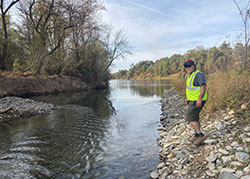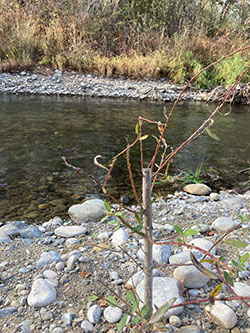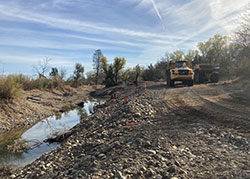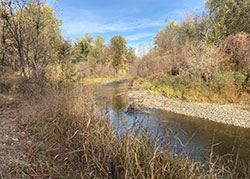Luis Santana, fisheries biologist for the Yurok Tribe, holds up a Chinook salmon carcass found in one of the side channels being constructed along the Sacramento River near Anderson in Shasta County.

Doug Killam, senior environmental scientist with CDFW’s Northern Region, stands along the first of three side channels that was excavated and connected to the main stem of the Sacramento River in 2020.

Willow and cottonwood cuttings have been placed throughout the side channels construction site. They will ultimately provide a cooling canopy for salmon and steelhead and relief from the areas’ scorching summer heat.

Creating three meandering side channels off the Sacramento River near Anderson has involved heavy construction and earth-moving equipment over the past 12 months.

An oasis of slow-moving, meandering, cooling waters with deep pools and oxygenating riffles off the Sacramento River near Anderson will offer new spawning and rearing habitat for both salmon and steelhead.
An oasis of meandering waterways with deep pools, shallow gravel beds, protective log overhangs, oxygenating riffles and a cooling canopy of willows and cottonwood trees is being created for salmon and steelhead along the banks of the Sacramento River on CDFW-owned property near the city of Anderson in Shasta County.
Three new side channels off the Sacramento River have been carved from a dense, 40-acre riparian zone and floodplain that is being reconnected to the river adjacent to the Anderson River Park. The new habitat will serve as a protective nursery for juvenile salmon and steelhead off the main river while providing additional spawning habitat for adult fish.
“This was designed for rearing habitat,” explained Doug Killam, a senior environmental scientist with CDFW’s Northern Region, on a recent tour. “The moment we opened up the first channel and connected it to the river, adult salmon started showing up right away.”
The side channel project at Anderson is one of two currently under construction along the Sacramento River – the other taking place in downtown Redding. Both projects are being overseen by the U.S. Bureau of Reclamation as part of the Central Valley Project Improvement Act to mitigate impacts from lost habitat resulting from the construction of the Shasta Dam in 1945. Rocks and gravel being added to the side channels for fish habitat historically would have been delivered from upper reaches of the Sacramento River and all of the tributaries above Shasta Dam.
The Bureau of Reclamation contracted construction of the Anderson-area project out to the Yurok Tribe, whose reservation is situated along the lower 44 miles of the Klamath River. The tribe’s culture is rooted in salmon and fishing along the North Coast. Construction began a year ago and is nearly complete.
Few outside materials were brought in. Almost everything used to create ideal and idyllic fish habitat – stumps and snags, gravel and stones, willow and cottonwood cuttings – were acquired locally at the construction site, repurposed and recycled. The side channels themselves were dug out and designed based on historic waterways that used to exist.
“The Yurok Tribe has been fishing for time immemorial and being a fisherman myself, we know what salmon want,” said Luis Santana, fisheries biologist for the Yurok Tribe. “Everything we’re doing here is in the best interest of native fishes.”
###
Media Contact:
Peter Tira, CDFW Communications, (916) 215-3858
CDFW Photos